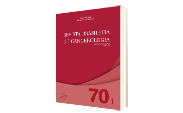Relation between Delay Time to Surgical Treatment of Prostate Cancer and Disease Recurrence Risk
DOI:
https://doi.org/10.32635/2176-9745.RBC.2024v70n1.4406Keywords:
Prostatic Neoplasms, Prostatectomy, Time-to-Treatment, Disease Progression, Neoplasm Recurrence, LocalAbstract
Introduction: There is no consensus in the literature on a reasonable delay time from diagnosis to radical prostatectomy (RP) surgery, without worsening the prognosis. Objective: To evaluate the influence of the delay on the risk of disease recurrence in patients with acinar adenocarcinoma of the prostate treated with RP. Method: Four hundred and twelve patients undergoing RP were retrospectively evaluated. Of these, 172 were excluded due to incomplete data and another 28 due to preoperative staging as high-risk prostate cancer (PSA > 10 ng/mL or Gleason score on biopsy > 7). Pre-and postoperative stagings were compared and survival analysis was performed using the Kaplan-Meier method to investigate the influence of time on discordance between pre- and postoperative stagings. Results: For the 212 patients of the sample, the average time from diagnosis to RP was 176.1 ± 120.2 days (median 145.5 days), ranging from 29 to a maximum of 798 days. The Kaplan-Meier curve indicated that the cancer worsened the longer the delay between diagnosis and surgery. Patients undergoing surgery within 60 days had an approximately 95% probability of not increasing the initial risk of recurrence. This number fell to 80%, 70% and 50% in patients operated on up to 100, 120 and 180 days, respectively. Conclusion: Delay in performing RP represents a continuous risk of relapse. The ideal time for RP is up to 60 days from prostate biopsy, as the probability of upstaging is less than 5% in this period.
Downloads
References
Santos MO, Lima FCS, Martins LFL, et al. Estimativa de incidência de câncer no Brasil, 2023-2025. Rev Bras Cancerol. 2023;69(1):e-213700. doi: https://doi. org/10.32635/2176-9745.RBC.2023v69n1.3700 DOI: https://doi.org/10.32635/2176-9745.RBC.2023v69n1.3700
Alonso AR, Blanco AF, Fernández SP, et al. Influencia de la demora quirúrgica en los hallazgos patológicos y el pronóstico de los pacientes con cáncer de próstata. Actas Urol Esp. 2009;33(10):1069-77. DOI: https://doi.org/10.1016/S0210-4806(09)73183-3
Antonopoulos IM, Pompeo ACL, Saldanha LB, et al. Gleason score comparative study between transrectal prostate biopsy and radical prostatectomy specimen. Int Braz J Urol. 2000;26(6):609-13.
Grossfeld GD, Chang JJ, Broering JM, et al. Under staging and under grading in a contemporary series of patients undergoing radical prostatectomy results from the cancer of the prostate strategic urologic research endeavor database. J Urol. 2001;165(3):851-6. DOI: https://doi.org/10.1016/S0022-5347(05)66543-3
Noguchi M, Stamey TA, McNeal JE, et al. Relationship between systematic biopsies and histological features of 222 radical prostatectomy specimens: lack of prediction of tumor significance for men with nonpalpable prostate cancer. J Urol. 2001;166(1):104-10. DOI: https://doi.org/10.1016/S0022-5347(05)66086-7
Obek C, Louis P, Civantos F, et al. Comparison of digital rectal examination and biopsy results with the radical prostatectomy specimen. J Urol. 1999;161(2):494-8. DOI: https://doi.org/10.1016/S0022-5347(01)61932-3
D‘Amico AV, Whittington R, Malkowicz SB, et al. Clinical utility of percent-positive prostate biopsies in predicting biochemical outcome after radical prostatectomy or external-beam radiation therapy for patients with clinically localized prostate cancer. Mol Urol. 2000;4(3):171-5.
Nam RK, Jewett MA, Krahn MD, et al. Delay in surgical therapy for clinically localized cancer and biochemical recurrence after radical prostatectomy. Can J Urol. 2003;10(3):1891-8.
Graefen M, Walz J, Chun KHF, et al. Reasonable delay of surgical treatment in men with localized prostate cancer - impact on prognosis? Eur Urol. 2005;47(6):756-60. doi: https://doi.org/10.1016/j.eururo.2005.02.004 DOI: https://doi.org/10.1016/j.eururo.2005.02.004
Korets R, Seager CM, Pitman MS, et al. Effect of delaying surgery on radical prostatectomy outcomes: a contemporary analysis. BJU International. 2012;110(2):211-6. doi: https://doi.org/10.1111/ j.1464-410x.2011.10666.x DOI: https://doi.org/10.1111/j.1464-410X.2011.10666.x
Sean Ong XR, Condon B, Bagguley D, et al. Safety first: evidence for delay of radical prostatectomy without use of androgen deprivation therapy during Covid-19. Future Oncol. 2020;16(20):1409-11. DOI: https://doi.org/10.2217/fon-2020-0388
Conselho Nacional de Saúde (BR). Resolução n° 466, de 12 de dezembro de 2012. Aprova as diretrizes e normas regulamentadoras de pesquisas envolvendo seres humanos. Diário Oficial da União, Brasília, DF. 2013 jun 13; Seção I:59.
O’Brien D, Loeb S, Carvalhal GF, et al. Delay of surgery in men with low risk prostate cancer. J Urol. 2011;185(6):2143-7. doi: https://doi.org/10.1016/j. juro.2011.02.009 DOI: https://doi.org/10.1016/j.juro.2011.02.009
Singer EA, Kaushal A, Turkbey B, et al. Active surveillance for prostate cancer: past, present and future. Curr Opin Oncol. 2012;24(3):243-50. doi: https://doi.org/10.109 7%2FCCO.0b013e3283527f99 DOI: https://doi.org/10.1097/CCO.0b013e3283527f99
Moul JW, Leon S, Amling CL. How long can radical prostatectomy (RP) safely be delayed? CPDR’s experiences from 3324 cases. J Urol. 2004;171(4sup):312. DOI: https://doi.org/10.1016/S0022-5347(18)38421-0
Freedland SJ, Kane CJ, Amling CL, et al. Delay of radical prostatectomy and risk of biochemical progression in men with low risk prostate cancer. J Urol. 2006;175(4):1298-303. DOI: https://doi.org/10.1016/S0022-5347(05)00646-4
Holmstrom B, Holmberg E, Egevad L, et al. Outcome of primary versus deferred radical prostatectomy in the National Prostate Cancer Register of Sweden Follow-up. Study J Urol. 2010;184(4):1322-7. DOI: https://doi.org/10.1016/j.juro.2010.06.008
O’Kelly F, Thomas A, Murray D, et al. Can delayed time to referral to a tertiary level urologist with an abnormal PSA level affect subsequent Gleason grade in the opportunistically screened population? The Prostate. 2013;73(12):1263-9. DOI: https://doi.org/10.1002/pros.22628
Instituto Vencer o Câncer. Projeto de investigação sobre o cenário do câncer de próstata no sistema de saúde público brasileiro. Leitura estratégica integrada: perfil epidemiológico e políticas públicas. São Paulo: Instituto Vencer o Câncer; 2020. [Acesso 2023 jun 15]. Disponível em: https://www.vencerocancer.org.br/wp- content/uploads/2020/12/LEI_InstitutoVencer_PDF_ Interativo_V4.pdf
Instituto Nacional de Câncer. Monitoramento das ações de controle do câncer de próstata. Bolet Inf detecção precoce. 2014;5(2):1-8.
Santos ROM, Abreu MM, Migowski A, et al. Ferramenta de apoio à decisão sobre o rastreamento do câncer de próstata no Brasil. Rev saúde pública. 2022;56:19. doi: https://doi.org/10.11606/s1518-8787.2022056003467 DOI: https://doi.org/10.11606/s1518-8787.2022056003467
Published
How to Cite
Issue
Section
License
Os direitos morais e intelectuais dos artigos pertencem aos respectivos autores, que concedem à RBC o direito de publicação.

This work is licensed under a Creative Commons Attribution 4.0 International License.









